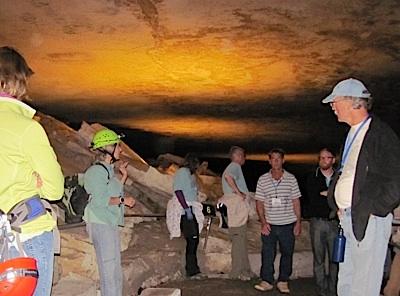Teams of scientists have headed into the Utah desert in years past to better understand life on other planets, so why not go underground to do the same? A recent workshop at Carlsbad Caverns National Park was intended to help scientists envision exploring caves on other worlds.
Last week's International Planetary Cave Research Workshop brought to the park an array of scientists representing the United States Geologic Survey (Astrogeology Science Center), National Aeronautics and Space Administration (Mars Program Office), Universities Space Research Association, Lunar and Planetary Institute, and the National Cave and Karst Research Institute.
Their goal?
To discuss things such as autonomous robots for exploring subsurface sites, ice caves, microclimates, lava tubes, microbial mats, and thermal imaging cave detection. Presenters described research they did in person or through various remote methods of such far flung locations as Antarctica, Mexico, Romania, Mars, Texas, Moon, Spain, Titan, New Mexico
and Saturn’s Rings, according to park officials.
This is not science fiction. Around the world, scientists and engineers are searching for, speculating about and devising ways to reach other planets and study extraterrestrial life. Because of their remoteness, harsh environments, and often “unreachable” places, exploring caves and lava tubes offers challenges similar to
exploring other worlds. Also, life forms that exist in extreme conditions underground – where the Sun’s energy is nonexistent, digestible resources are scarce, and competition is high – may have qualities akin to what we’d expect to find off-world. The assertion is that knowing what evidence of life looks like here, such as chemical
signatures or microbial patterns, may help us recognize signs of life, past or present, throughout the solar system.
Dr. Penny Boston, who led NASA’s Caves of Mars Project, helped assemble and organize the
workshop.
“One of my primary interests is looking at the caves on Earth, in all their spectacular diversity, and rethinking them in the context of another planetary body," said Dr. Boston.
For more than two decades much of her geomicrobiology research has been done in national parks, including Carlsbad Caverns National Park.
“National parks exist to help us understand and appreciate our world,” added Dale Pate, the Cave and Karst coordinator for the National Park Service. “It’s great that science occurring in parks could help us understand not only this world we’re on but also other
worlds beyond.”
It should be no surprise to hear that scientific research is ongoing in national park sites, but perhaps it’s incredible to imagine that earthly explorations could reach from a microbe in a
national park cave to the discovery of life beneath the surface of Mars!




Add comment